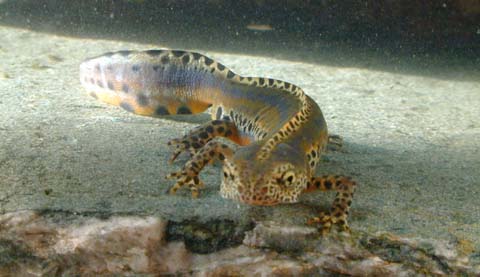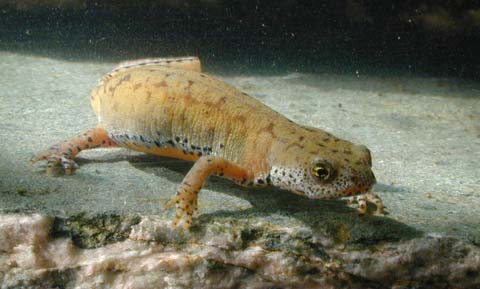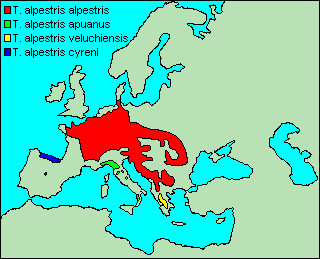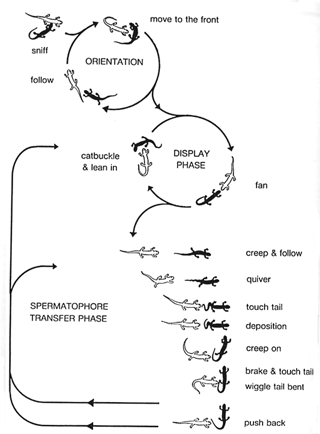

Male T. alpestris.

Female T. alpestris.


Mating behaviour: male shown in black, female in white. From Arntzen & Sparreboom (1989).
DESCRIPTION
The alpine newt growns to a size of around 10 cm., although females are larger than males. Both sexes have a dark grey, or grey-blue colouration, which may have subtle blotches or marblings in similar shades. The belly is unspotted (although the throat may have some spotting) and is yellow-orange to reddish. Breeding males have a whitish band with black spotting, running from the cheeks, along the lower side of the flanks, onto the cloaca. They have a low straight crest which is also whitish with dark spots.
SUBSPECIES
A large number of subspecies of T. alpestris have been described, many with a very small range, many describing populations with a high rate of neoteny/paedomorphosis. Recent work (e.g. Sotiropoulos et al, 2007; Luznik et al, 2011) suggests that only the four most widespread subspecies are valid.
T. a. alpestris
The nominate form is found over much of central Europe,
southwards to the Balkan peninsula, and east to the Ukraine.
T. a. apuanus
Found in Italy (although some believe
the isolated southern Italian populations to be a separate
subspecies, T.a. inexpectatus), and south-eastern France.
This subspecies differs from a. alpestris in having a heavily spotted throat.
Neoteny/paedomorphosis is frequently observed in apuanus.
T. a. cyreni
This form occurs in isolated populations in central and northern
Spain. Individuals from this subspecies have a wider, rounder head than a. alpestris.
T. a. veluchiensis
T. a. veluchiensis occurs in the Veluchi mountains, in
central Greece.
Other subspecies described include carpathica, from Romania; lacusnigri, restricted to Lake Crno in Slovenia, and believed extinct (Vogrin, 1996); montenegrinus, highly neotenous, and found only in Bukumirsko Lake in Montenegro; piperianus, mainly neotenous and restricted to Montenegro; reiseri, found in the Vranika mountains in Bosnia; and serdarus, mainly neotenous and again found only in Montenegro.
REFERENCES
Arntzen, J. W. & Sparreboom, M., 1989. A phylogeny for the Old World newts, genus Triturus: biochemical and behavioural data. J. Zool., Lond. 219: 645-664. [ABSTRACT]
Luznik, M., Buzan, E. V. & Krystufek, B., 2011. Mitochondrial sequences do not support the independent taxonomic position of the extinct Alpine newt subspecies Mesotriton alpestris lacusnigri. Amphibia-Reptilia 32: 435-440. [ABSTRACT]
Sotiropoulos, K., Eleftherakos, K., Dzukic, G., Kalezic, M. L., Legakis, A. & Polymeni, R. M., 2007. Phylogeny and Biogeography of the Alpine Newt Mesotriton alpestris (Salamandridae, Caudata), Inferred from mtDNA Sequences. Molecular Phylogenetics and Evolution 45: 211-226. [ABSTRACT]
Vogrin, N., 1996. An Overview of the Herpetofauna of Slovenia. British Herpetological Society Bulletin 58: 26-35.
